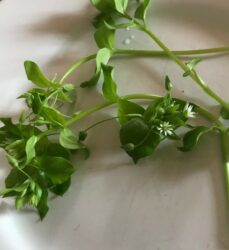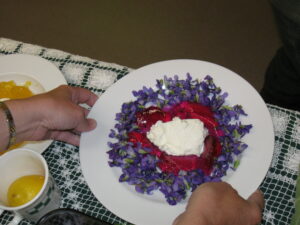By Wren Smith

During this pandemic some of you may be like me – you find your cabinets stocked with cans of tomatoes, tuna, beans, and boxes of pasta, and varied other dried, canned, or processed things. Perhaps like me, you’ve eaten the last of the lettuce, kale, and spinach, and suddenly you crave those luscious leafy greens!
Our bodies often know what we need. When we open our refrigerators, the crisper drawers yawn back, perhaps mocking us for assuming they could keep a stockpile of greens fresh and on hand for weeks on end. The emptiness here only intensifies our desire for what may not be readily available.

Hopefully you have taken this virus and the necessity of social distancing seriously. I sure have. In fact, I haven’t been to the grocery store in over three weeks, and that’s why the hunger for something fresh or green has hit me. I am grateful to my lifelong love of foraging. Now, in these strange and uncertain times, this knowledge seems more relevant. I step outside, and there, just beyond my doorstep, is all I need to make a lovely spring salad. Chickweed, sheep sorrel, dandelion greens, wild garlic and its close relative, wild onion, and violet leaves and blossoms all offer themselves up for free. The leaves of the common blue violet (Viola sororia) are loaded with vitamin A and C, and I find them still young, tender, and abundant. The edible blossoms from my redbud trees (Cercis canadensis) make this salad a feast for the eyes and its beauty lifts my spirits. Perhaps the act of taking time to look carefully, to notice the beauty about me – the northern cardinals, and brown thrashers gathering their nesting materials, and the bees buzzing about, also gathering what they need – contribute to a renewed sense of hope and perhaps health.

A few of the arrow-shaped leaves of sheep sorrel (Rumex acetosella) add a nice tartness to my salad, but as with any wild food, never eat too much at one time. I was glad to find this cute but aggressive weed before it set up house in my garden. If I have to pull weeds, I’d prefer those I can eat.

Chickweed (Stellaria media) makes a great addition to a spring salad, providing it’s gathered when the shoots are young and tender. It seems to be everywhere. No wonder Euell Gibbons, the wild foods guru of my youth, called it, “garden whoosh.” It does tend to whoosh over any sunny disturbed location! Not only did Mr. Gibbons enjoy the shoots in a salad, but also in one of his famous green drinks. I’ve made my own version of this, adding it to a blender with apple or other juices, in place of kale and it’s not bad. Of course it’s even better with frozen bananas.

Making violet jelly is one of my favorite rituals of spring. I was inspired over thirty years ago by a Euell Gibbon’s recipe, from his book Stalking the Helpful Herbs. Each spring since, making this treat infuses me with a certain youthful glee, or perhaps a sense that I’m practicing an ancient form of alchemy. I love watching the transformation as the boiling water I’ve poured over the freshly harvested violet blossoms (crammed into a mason jar) turns a vibrant indigo color in just a few hours. I strain out the spent blossoms and measure this lovely liquid into a clear glass jar. Holding it up to the light, I admire its dazzling color. It’s also a delight to watch this liquid turn from indigo to a lovely purple as soon as I add the recipe’s required lemon juice and pectin. The taste of the finished product is delicate – not the kind of jelly to slather over toast. I prefer it with a little cream cheese and crackers. A quick Google search will lead you to recipes that are near identical to his classic.

This blog post is not meant to be a tome on foraging for food, but merely an encouragement to think about foraging as a way to find fresh and free food in a time where it may be in short supply. It’s also another way to slow down and connect with nature. I know that I am lucky to have nearly an acre to forage right out my back door, but most of the plants listed here are considered weedy species and are readily available even in small yards, urban landscapes, and local right-of-ways. But it’s always a good idea to make sure that the plants you harvest are growing in a safe location and have not been sprayed or otherwise made less wholesome through other forms of pollution. Foraging, if done thoughtfully, can add freshness and nourishment for the body and the soul.
If you decide to forage for food please keep these tips in mind.
Wren’s Tips for Foraging for Food
- Make positive identification of any plant you hope to consume. I cannot emphasis this enough!
- Learn to recognize the most dangerous plants in our area. Poison hemlock (Conium maculatum) and spotted water hemlock (Cicuta maculata) are both members of the carrot (Apiacea) family and people have died mistaking them for wild carrots.
- Carefully research each plant to make sure that you know how to safely prepare it; some plants must be cooked or even parboiled. Some plants have poisonous as well as edible parts.
- Use scientific names when doing your research, since many plants share the same common name and/or have many common names.
- Gather from areas not treated with pesticides, herbicides, or pollutants. But still wash your harvest.
- Never eat too much of any new food, wild or otherwise. For example, docks (Rumex) species and sorrels (Oxalis) species contain concentrations of oxalic acid, that can be harmful in large quantities. It is also possible to have an allergic reaction to a food that most people have no difficulty eating. If you are pregnant or taking medications, you should consult your doctor before eating wild foods to avoid the risk of chemical/drug interactions.
- Conduct your own research and include new sources of information. Use multiple and updated references.
- Be a thoughtful and respectful forager. Get permission if venturing on others’ property to forage and always leave plenty for other creatures that might depend on it.

